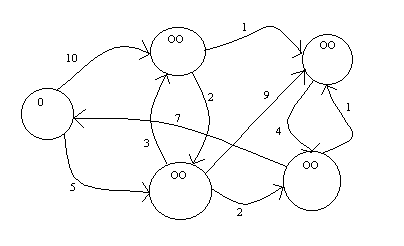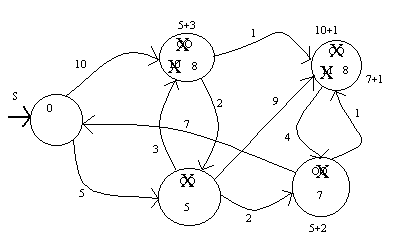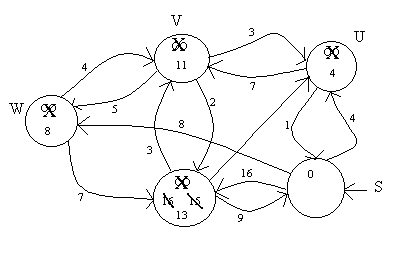Dijkstra's Algorithm Goal: To find the shortest path to each node length(v,w)>=0 set the upper bound on each node equal to infinity
 shortest path to s is s = 0
in order of cheapest nodes
shortest path to s is s = 0
in order of cheapest nodes
 look at outgoing arc and decide is it connects to a node
Pseudo Code:
Let S <- {s}
d[s] <- 0; d[v] <- oo (for all v in V not equal to s)
while S != v
- find a v with minimum d[v]
- S <- S union {v}
- for all w <- adj(v) - S
if d[v] + length(v,w) < d[w]
d[w] <- d[v] + length(v,w)
look at outgoing arc and decide is it connects to a node
Pseudo Code:
Let S <- {s}
d[s] <- 0; d[v] <- oo (for all v in V not equal to s)
while S != v
- find a v with minimum d[v]
- S <- S union {v}
- for all w <- adj(v) - S
if d[v] + length(v,w) < d[w]
d[w] <- d[v] + length(v,w)
another example length(v,w)>=0
 0 label is fixed, put in set. Then check all outgoing vertices
record predecessor
(13,v) tells where 13 came from
(11,u)
(4,s)
can recover a path, finds the shortest path to 13
(s,u,v,y)
0 label is fixed, put in set. Then check all outgoing vertices
record predecessor
(13,v) tells where 13 came from
(11,u)
(4,s)
can recover a path, finds the shortest path to 13
(s,u,v,y)
Using a heap to implement Dijkstra's algorithm Heap h; for i <- 1 to n do { node[i].d = infinity; } node[s].d = 0; for i <- 1 to n do { h.insert(node[i]); } for i <- 1 to n do { v = h.delete_min(); for eack w in adj(v) if v.d + length(v,w) < w.d delta = w.d-v.d-length(v,w) h.decrease_key(w,delta) }
efficiency of Algorithm n calls to insert n calls to delete_min m calls to decrease_key (m = # edges, at least the size of n) try to find a more efficient method
heap implementations: | Sorted | (min) | Fibonacci | Linked List | binary heap | Heap ------------------------------------------------------------ | | | insert | theta(n) | theta(lgn) | theta(1) amortized ------------------------------------------------------------ | | | delete_min | theta(1) | theta(lgn) | theta(lgn) amortized ------------------------------------------------------------ | | | decrease_key | theta(n) | theta(lgn) | theta(1) amortized ------------------------------------------------------------ | | | Total Time | O(n^2+n+mn) | O(nlgn+mlgn) | O(n+nlgn+m) | O(mn) | O(mlgn) | O(m+nlgn)
binomial heaps - a doubly linked list of heap ordered binomial trees - each node records 1. degree 2. youngest child 3. net older sibling - one pointer, min, to the tree with the smallest root